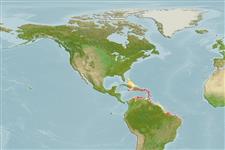Environment: milieu / climate zone / depth range / distribution range
Ekologi
marina bottenlevande; djupintervall 0 - 5 m (Ref. 86997), usually 0 - 2 m (Ref. 40849). Tropical; 28°N - 15°S, 78°W - 14°W
Western Atlantic: West Indies to Brazil. Southeast Atlantic: Ascension Island.
Length at first maturity / Size / Vikt / Age
Maturity: Lm ?, range 23 - ? cm
Max length : 34.3 cm TL hane/ej könsbestämd; (Ref. 116955)
Inhabit coastal waters (Ref. 5217). Adults are found in shallow depth near sand; juveniles often in rockpools (Ref. 86997). Oviparous, eggs are pelagic and non-adhesive (Ref. 205).
Life cycle and mating behavior
Könsmognad | Reproduktion | Lek | Ägg | Fecundity | Larver
Thomson, J.M., 1978. Mugilidae. In W. Fischer (ed.) FAO species identification sheets for fishery purposes. Western Central Atlantic (Fishing Area 31). Vol. 3. [pag. var.]. FAO, Rome. (Ref. 3791)
IUCN Red List Status (Ref. 130435: Version 2024-1)
Threat to humans
Harmless
Human uses
Fiskeri: saknar intresse
Verktyg
Special reports
Download XML
Internet-källor
Estimates based on models
Preferred temperature (Ref.
123201): 26.9 - 28.1, mean 27.4 °C (based on 216 cells).
Phylogenetic diversity index (Ref.
82804): PD
50 = 0.5000 [Uniqueness, from 0.5 = low to 2.0 = high].
Bayesian length-weight: a=0.01023 (0.00587 - 0.01783), b=2.93 (2.78 - 3.08), in cm total length, based on LWR estimates for this species & Genus-body shape (Ref.
93245).
Trofisk nivå (Ref.
69278): 2.0 ±0.00 se; based on food items.
Resiliens (Ref.
120179): Mellan, lägsta populationsfördubblingstid 1,4-4,4 år (Preliminary K or Fecundity.).
Fishing Vulnerability (Ref.
59153): Low vulnerability (24 of 100).
